
WASHINGTON — More cities, including the remote Xinjiang capital of Urumqi, announced Sunday (November 4) the easing of coronavirus restrictions after massive anti-blockade protests broke out in several major Chinese cities and nearly 100 colleges and universities last weekend, and strive to implement the "dynamic zeroing" policy more accurately, rather than causing a comprehensive impact on people's livelihood at every turn.
Urumqi, where recent demonstrations against the harsh lockdown first broke out, will reopen shopping malls, markets, restaurants and other venues from Monday, ending more than three months of a severe lockdown.
In Beijing's Liangmaqiao area and Shanghai's Urumqi Road, there was a heavy police presence this weekend and there was no sign of protests. Protests were most active in those two areas a week ago.
A fire broke out in a residential building in Urumqi on November 24. Due to the lockdown, the doors of the residents’ houses and buildings were locked, making it impossible for people to escape, and the fire trucks could not extinguish the fire in time due to the lockdown of the community, and could not even get close to it. , killing what officials say is at least ten people. Netizens and outside rumors said that the death toll was at least 30 to 40 people. However, officials have denied many facts.
The tragic fire sparked protests against the harsh lockdown in Urumqi and more than two dozen other cities, creating a civil disobedience movement unprecedented since Xi Jinping came to power in 2012.
Since last week's protests, several Chinese cities have announced the easing of lockdowns, testing requirements and quarantine rules.
Reuters reported on Sunday that Sun Chunlan, China's vice premier in charge of the epidemic, said last week that the pathogenicity of the Omicron virus had weakened and that prevention and control measures would be optimized. This is clearly an official change in attitude towards the epidemic.
Officials will announce further relaxations in testing requirements across the country, allowing positive and close contacts to stay at home under certain conditions, sources told Reuters, the report said.
Shanghai authorities announced on Sunday that from Monday, citizens will not need to show a negative test to take public transport or enter and leave parks.
Nanning, the capital of Guangxi, announced earlier on Sunday that it would cancel the negative test requirement to ride the subway.
On Saturday, Beijing authorities said registration was no longer required to buy medicines for fever, cough, and sore throat. Authorities had previously imposed the restriction because it was believed many people were taking the drugs to mask coronavirus infections.
Some districts and counties in Beijing have recently announced that people who test positive can be quarantined at home. Other inconsistencies, however, have irritated the public, including the need for negative 24-hour nucleic acid tests at many venues despite the closure of many large-scale testing centers. This means that it will be more difficult for people to get tested and the queues will be longer.
A netizen complained, "Are they stupid or despicable?" Before the nucleic acid testing code was canceled, the testing station should not be closed.
The "clearing" epidemic prevention and control, which has become the benchmark for the political governance of Chinese Communist Party leader Xi Jinping, has had a devastating impact on the economy of world's second-largest economy and has also seriously affected the global supply chain. The Chinese authorities have argued that a “zero-clearing” epidemic prevention policy that only closes the border is necessary to save lives and prevent the collapse of the medical system.
Although the strict lockdown has been eased, many experts say that at least until the two sessions of the National People's Congress and the Chinese People's Political Consultative Conference in March next year, it is impossible for the authorities to start any major reopening actions, especially because the authorities need to speed up vaccinations, especially in the vast majority of people. in the elderly population.
Goldman Sachs Investment Bank said in a research report on Sunday that although there have been some recent local changes in the containment of the new crown virus epidemic, these changes cannot be interpreted as China's abandonment of the "clearing" epidemic prevention policy.
According to the New York Times, in recent years, the Chinese government has used its propaganda tools to promote the horror of the new coronavirus in order to justify the large-scale full-scale testing, isolation, and monitoring of its population of more than one billion. As the authorities have had to start changing their approach to the outbreak, they are again faced with the task of allaying these fears among the population.
Until last week, government officials and the state-controlled media were emphasizing the most unfortunate medical news about the outbreak. They touted the high death rate of the epidemic in other countries, especially the United States, as well as months of respiratory problems, cognitive impairment, and other sequelae.
Experts say China is facing a challenging time in its response to the outbreak, one of the main reasons being confusing information about the virus. Moreover, the authorities have failed to take effective public health measures, such as aggressively promoting vaccination, putting a large number of elderly people at risk.



0 Comments